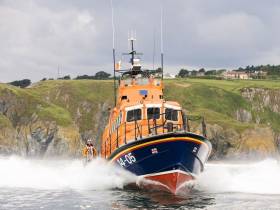Displaying items by tag: RNI
Dun Laoghaire & Wicklow Lifeboats Launch To Paddle Boarder In Distress
#Lifeboats - Dun Laoghaire RNLI responded to a stand-up paddle boarder who got into difficulty between Bray Head and Greystones yesterday afternoon (Sunday 27 January).
The volunteer lifeboat crew were requested to launch their all-weather lifeboat at 12.03pm and were on the water at 12.20pm.
The Irish Coast Guard helicopter Rescue 116 and Wicklow RNLI’s all-weather lifeboat were also tasked to the incident south of Bray Head.
Weather conditions were not good, with strong gale-force winds.
Dun Laoghaire’s crew of seven spotted the casualty who was clinging to his board and appeared in trouble.
Thirty-nine minutes after launch, the crew had the casualty onboard their lifeboat and quickly assessed he was suffering from “serious hypothermia”.
The casualty was airlifted to hospital by the coastguard. Wicklow RNLI recovered the paddle board and stood by as the casualty was winched onto the helicopter.
Commenting after the callout, Dun Laoghaire RNLI second coxswain Eamon O’Leary said: “The paddle boarder had suffered serious hypothermia when we arrived on the scene.
“It was a close call but he did the right thing in calling the coastguard who were quick to send out 116 along with Wicklow RNLI. It was fantastic teamwork by all involved.”





























































